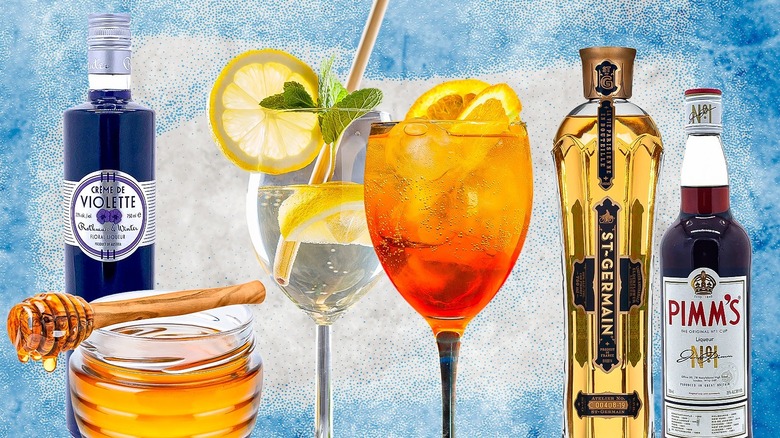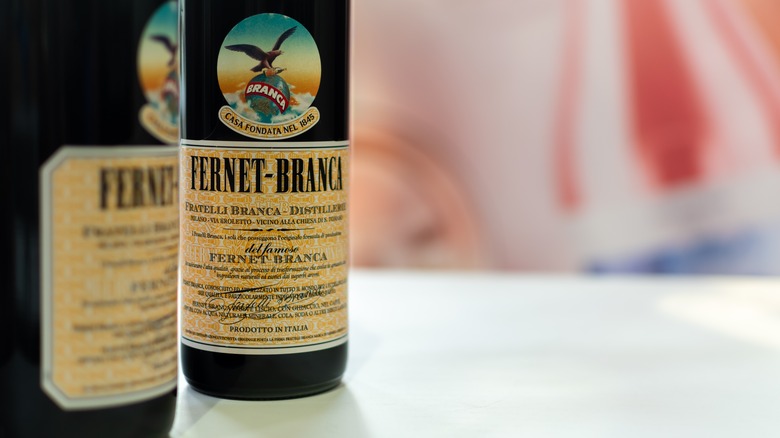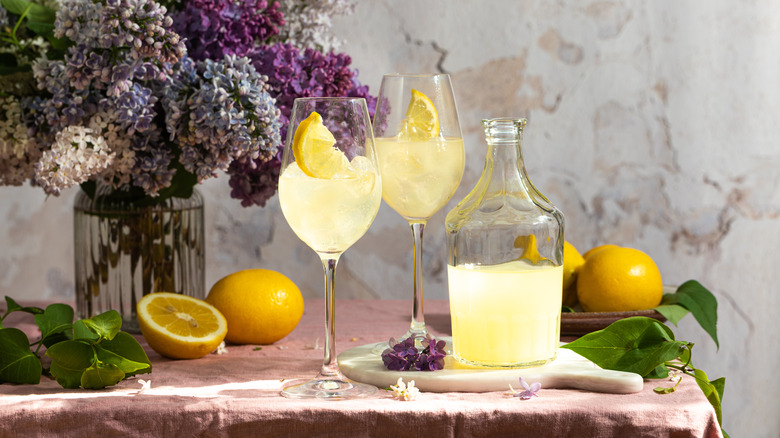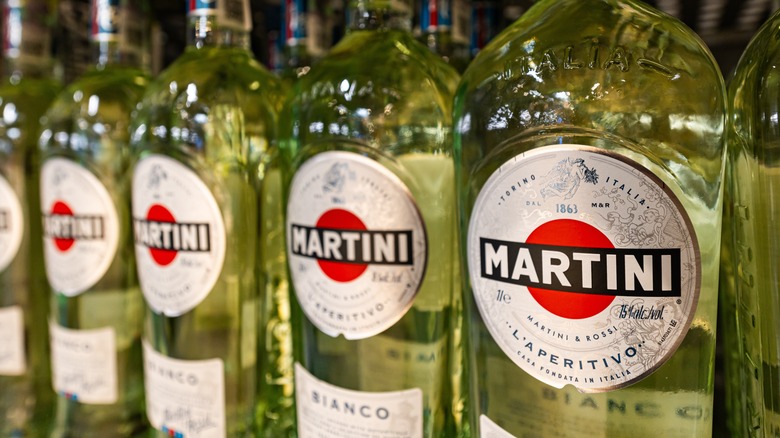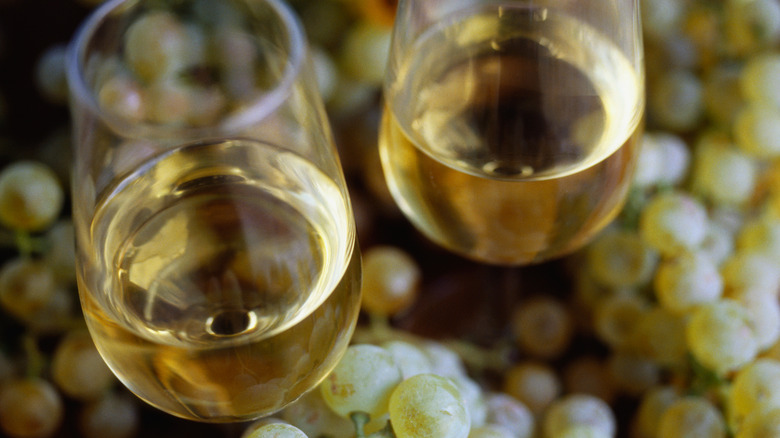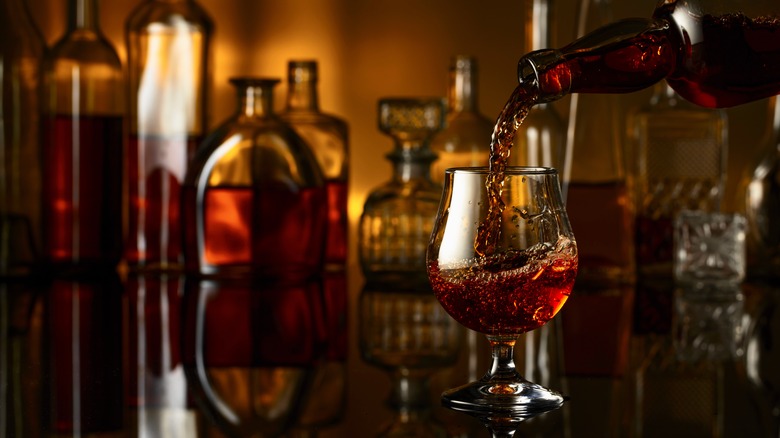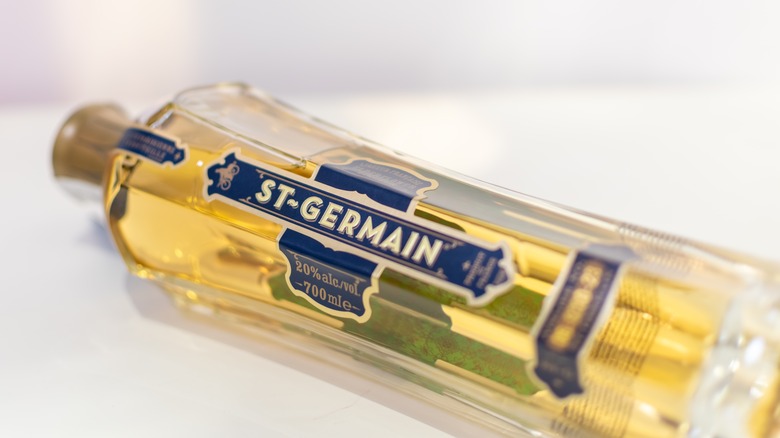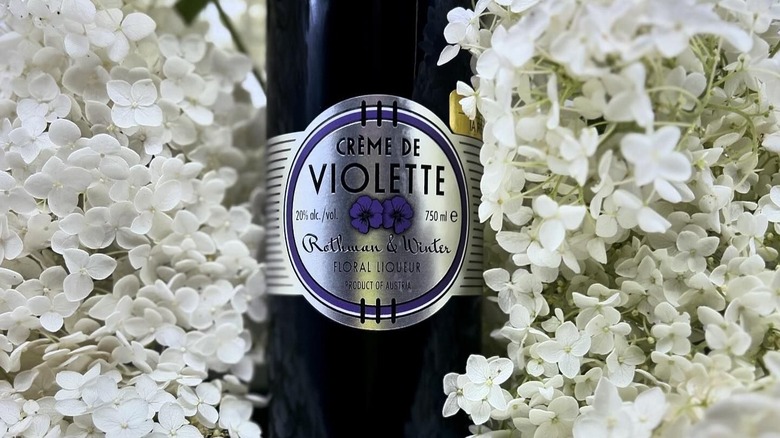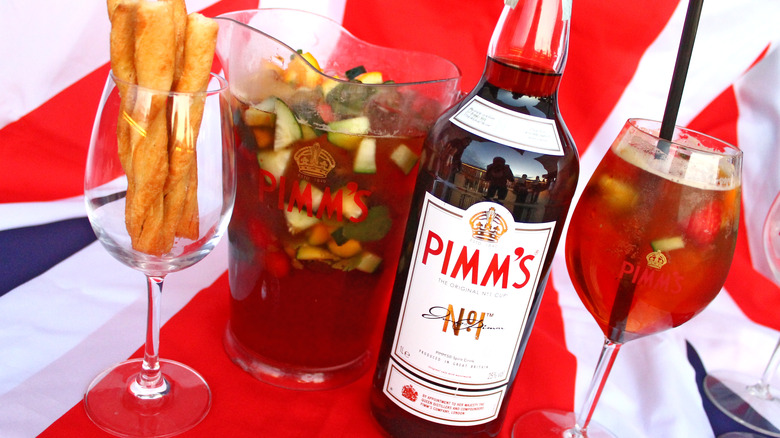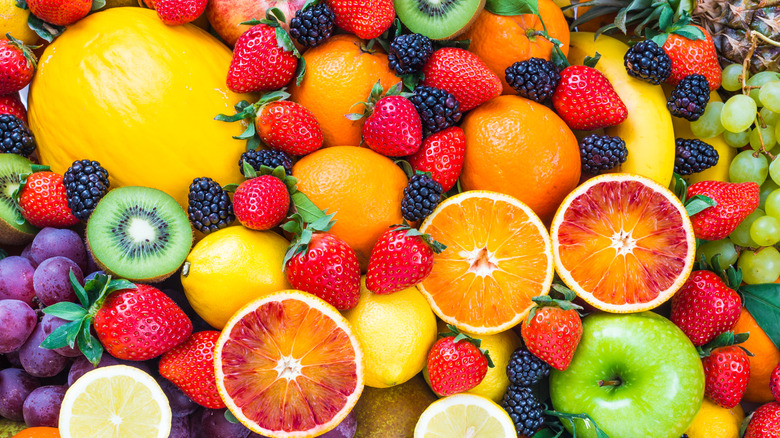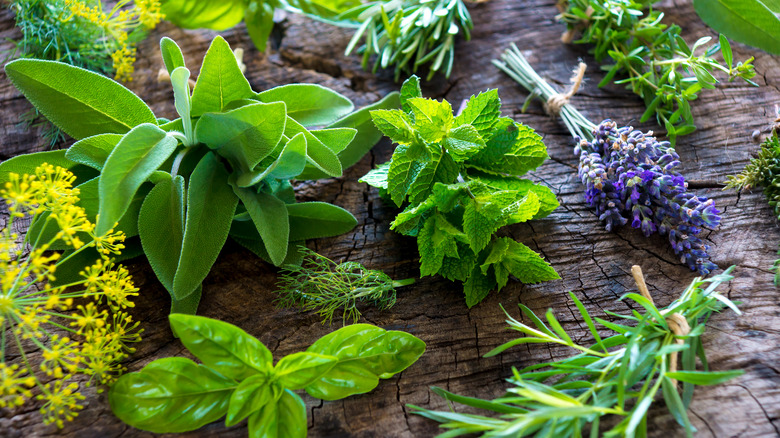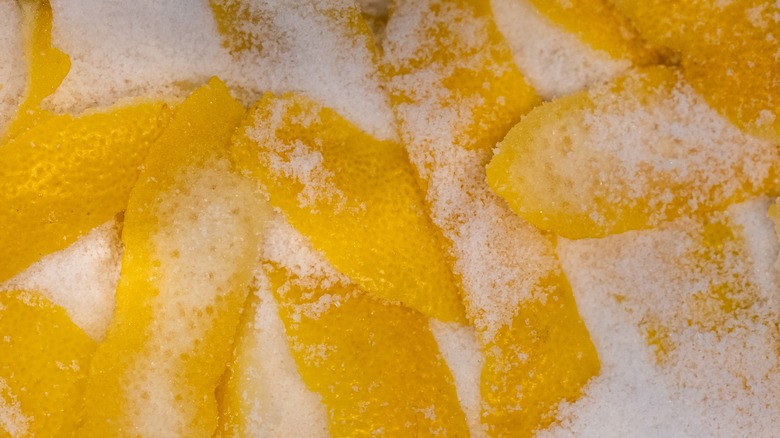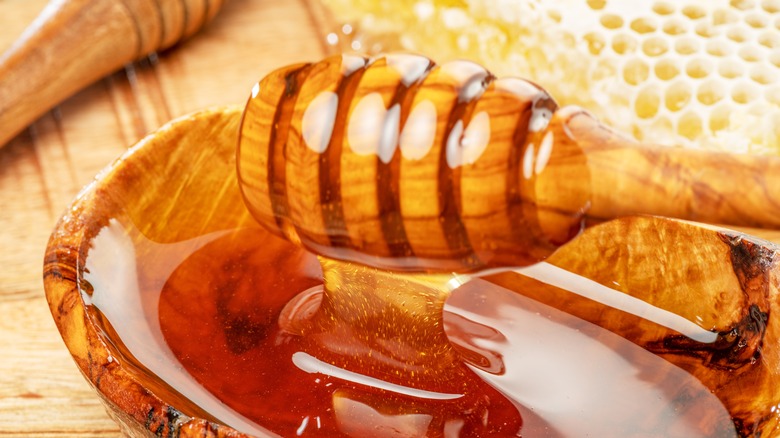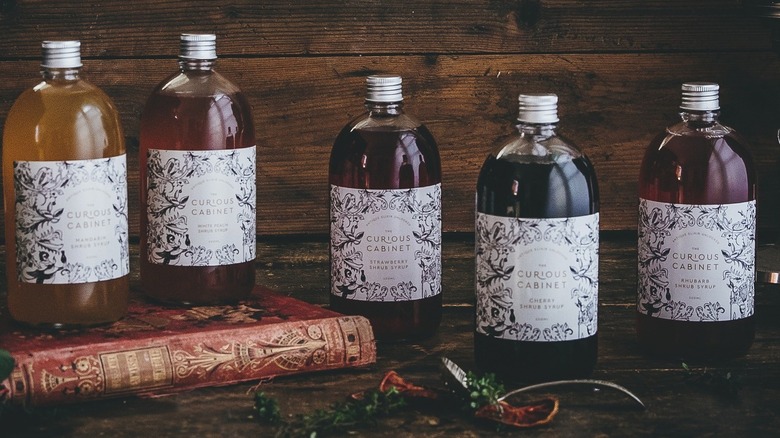15 Absolute Best Add-Ins To Elevate Your Next Spritz Drink
When the sun's shining and it's time to soak up some rays with a cocktail in hand, there are few drinks better suited to the occasion than a spritz. The modern form of the spritz was invented in Italy about a century ago, consisting of sparkling Prosecco wine mixed with a bitter digestif, topped with soda water. These days, the most popular version of the cocktail is arguably the Aperol spritz, or possibly a simple white wine and soda.
As an ex-professional cocktail bartender, I've made more than my fair share of Aperol spritzes. It's a modern classic for a reason; however, it barely touches the surface of what the drink can be. Over the years, I've played around with dozens of different recipes and ingredients to explore the cocktail's versatility. I've substituted different wines and liqueurs and experimented with unique additions to tweak the cocktail's profile. Below are the most effective add-ins I've found throughout my experiences, and I guarantee you'll find something to boost your next spritz, whatever your taste may be.
Fernet-Branca
Although Aperol is probably the most common liqueur used in spritzes, it belongs to a large, diverse family of Italian digestifs. If you love the bitter qualities of an Aperol spritz, this is a great place to start if you're looking for alternatives that'll give your cocktail a unique twist. Fernet-Branca is a digestif that belongs to a family of herbal liqueurs known as amari, and it's a superb ingredient if you want something with a complex and intense flavor.
Although Fernet-Branca's recipe is a closely guarded secret, the liqueur is infused with 27 different herbs, spices, and roots from across the world. The result is an ingredient that has powerful notes of eucalyptus, menthol, and anise which are superb for cutting through your spritz' sweeter elements. While you can rely solely on Fernet-Branca for the bitter component of your recipe, it may be a little overpowering. Personally, I prefer to use a 3:1 ratio of Aperol to Fernet, which results in a richer drink that retains the refreshing spirit of the original.
Limoncello
While limoncello is also an Italian liqueur that's typically enjoyed as a digestif, its flavor profile is a far cry from its bitter cousins. Made from sugar, alcohol, and lemon peels, it's incredibly sweet and has all the bright and zesty citrus notes of fresh lemons without the acidity.
Bitter liqueurs aren't everyone's cup of tea, but that should never get in the way of being able to enjoy a refreshing spritz. If you prefer sweeter drinks, limoncello is the perfect liqueur for the job. While I do enjoy a more saccharine tipple from time to time, pairing limoncello with a sweeter style of Prosecco can be overkill and may taste slightly cloying. In my experience, a sweet spritz works better with a drier wine, as the flavors will balance each other out. There are heaps of great Limoncello brands to choose from and it's typically pretty easy to get hold of a bottle. The good news is that even if you can't find any, Limoncello is incredibly easy to make at home, as long as you give yourself enough time for the ingredients to infuse properly.
Vermouth
While fortified wines have been around for centuries — originally used as a medicinal drink — we have Italy to thank for the modern iteration of the beverage. At the tail end of the 18th century, Italians began enjoying vermouths as an aperitif, and by the end of the 19th century, it began showing up in classic cocktails, like the Negroni and Manhattan.
Aromatic and complex, vermouths come in a variety of styles, each with its own characteristics to contribute to a spritz. They range from white to red and sweet to dry, meaning you've got plenty of options to choose from. However, picking the best vermouth for mixing drinks can take some experience due to the many different brands and styles. If you want to create a richer-tasting spritz, sweet red vermouth will amplify both the sweet and bitter aspects of the drink. If you prefer a crisper spritz, a dry white vermouth is perfect and will complement floral and herbaceous elements. That said, you may want to use a sweeter base wine or add a dash of sugar syrup to help balance the flavor profile.
Fino sherry
Like vermouth, sherry is another style of fortified wine; however, the two are quite distinct. Sherry comes from Spain, and while vermouth is flavored with aromatics, sherry is uninfused, giving it a more grape-forward flavor profile.
Sherry comes in a huge range of styles, all of which have their place in cocktails, but I prefer fino sherry for a spritz. The driest of all sherries, fino is extraordinarily light and crisp, which helps keep your cocktail refreshing while still contributing a stunning depth of flavor. It's a little herbaceous and slightly nutty, and it's aged under a layer of yeast which gives it a bready, doughy aspect. Plus, it has a noticeable salinity which reduces the perceived bitterness of bitter ingredients in the spritz. You can use it in place of your base wine but it's equally effective as an extra ingredient. I've also found it works well in conjunction with sweet red vermouth, as the flavors balance well and create a stunning complexity without becoming muddy or overpowering.
Brandy
If you're after a spritz with a touch more depth and warmth — something more suited for the colder months, perhaps — you can't beat brandy. It's the name we give to any spirit that's distilled from fermented fruit juice, so the term brandy covers a remarkable range of styles.
Cognac is probably the most famous type of brandy. Despite coming from a single region of France, it boasts a dizzying array of flavor profiles, making it highly versatile. You've also got Cognac's earthier, more complex counterpart, Armagnac, and the apple-based Calvados — and that's just France. If you're looking for a specific fruit flavor, there's an extremely good chance you'll be able to find a brandy that fits the bill. Younger brandies are a better choice for a lighter cocktail, while well-aged ones will contribute richer flavors with some barrel character. I suggest using brandy as a substitute for the liqueur component of your spritz; however, it can also play well with vermouths and complementary fruit liqueurs.
Chartreuse
Chartreuse is one of my favorite cocktail ingredients for a few reasons. I love spirits with an interesting history, and few can hold a candle to this pungent and intricate concoction. Chartreuse's background is something of a mystery, given it's been around for nearly a thousand years. It's produced by a single order of French monks, who still closely guard their 130-ingredient recipe.
Chartreuse is superb for introducing a boldly herbaceous dimension to a spritz, and it's great for balancing sweeter ingredients. There are also two different styles to choose from, giving you a bit of flexibility in how you use it. Green Chartreuse is the stronger, earthier expression, while yellow Chartreuse is softer and sweeter, with a slightly honeyed profile. However, its powerful character and high alcohol content mean you need to be careful when pairing it with other ingredients. For a spritz, I generally stick to Prosecco, soda, Chartreuse, and a splash of citrus. The one drawback is that Chartreuse is getting harder to find these days. Global demand has continued to increase, but the fact remains that Chartreuse is made by practicing monks. Understandably, their priorities lie elsewhere.
Elderflower liqueur
In the late 2000s, a new liqueur appeared that took the bartending world by storm — elderflower liqueur. Elderflower liqueur is made with fresh blossoms or flower extract, and it's unbelievably versatile. In fact, it's even earned itself the nickname "bartender's ketchup," thanks to its popularity among the mixology crowd.
Elderflower liqueur manages to achieve an impressive balance between its myriad flavor aspects. It's aromatic, herbaceous, and floral, but not oppressively so. There are notes of citrus, stone fruit, tropical fruit, and orchard fruit that intermingle without vying for your attention. Elderflower is complex enough to use solely with soda and Prosecco, yet multifaceted in a way that begs for experimentation with other ingredients. Elderflower liqueur leans toward the sweeter side, so a drier Prosecco is a good pairing, and I like to add a little gin to emphasize its botanical qualities. While St. Germain was the first, and is arguably the most popular brand of elderflower liqueur, many others have since jumped on the hype train, so it's not hard to find. Although some in the bartending world feel it's overused, I believe it's just a testament to how effective elderflower liqueur can be.
Creme de violette
Like Chartreuse, crème de violette is one of those ingredients that most people love or hate. Flavored with violet petals, it has an intensely floral and aromatic profile. If that's your thing, you're in luck. Most people know about crème de violette thanks to the Aviation cocktail, an official IBA cocktail and the most well-known drink to feature the perfumed liqueur. However, I feel like crème de violette has more uses than its given credit for, and one of those is in a fragrant spritz.
Crème de violette has a subdued sweetness that pairs well with drier wines, and its flowery nature makes it a great match for citrusy ingredients. In fact, I highly recommend combining it with elderflower liqueur, as the two ingredients lift each other's tasting notes beautifully. Flavor aside, crème de violette is a striking ingredient that stands out thanks to its vivid purple hue. Adding it to your spritz is a superb way to make your drink visually pop.
Pimm's
If you've not heard of Pimm's, I won't blame you. However, for Brits like myself, it's a summer staple that's quaffed in gardens up and down the country on those rare occasions the sun shows its face. Invented in 1840, Pimm's is a gin-based beverage known as a fruit cup.
Fruit cups are an English specialty — a beverage designed to be lengthened with a carbonated mixer, like lemonade or ginger ale. In our case, this also makes it perfect for combining with sparkling wine. Pimm's is fruity and mildly spiced with a slightly botanical character due to the gin base. It's typically served with a variety of fresh fruit and mint to enhance the flavors. Although Pimm's is somewhat bitter, it's not as powerful as liqueurs like Aperol or Campari, making it a great choice for a gentler spritz that leans into the fruity flavors. It's also quite versatile, so you can fortify your spritz with a little extra gin, or try elevating the Pimm's with a fruit-forward liqueur.
Fresh fruit
With few exceptions, no cocktail is complete without the right garnish. Besides looking pretty, garnishes help boost the aroma and flavor of a drink. I find that they're extra effective in spritzes thanks to the cocktail's effervescence, as the bubbles boost the impact of the aromatics.
Arguably the most effective garnish for a spritz is fresh fruit. Although using just the peel can be an elegant touch, it's better suited for cocktails where you don't want the fruit juice to interfere with the core ingredients. However, for a spritz, garnishing with a fruit slice, wedge, or wheel is the way to go, as the extra juice will improve the overall flavor. Plus, you get to nibble on the delicious booze-infused garnish afterward. You can use more than one type of fruit but the main thing to bear in mind is that you want your garnish to complement the flavors in your spritz. Citrus, stone fruit, berries, and orchard fruits are all great options depending on your choice of wine and liqueur. You'll want to make sure you're balancing flavors too — for example, tart citrus is a great way to balance sweeter ingredients, whereas sweet fruits are ideal for cutting through more bitter ingredients.
Fresh herbs
If you prefer a herbaceous or floral spritz, there's no better way to enhance those characteristics than with fresh herbs. Some herbs will also contrast beautifully with fruit, so you can use a combination of the two to great effect.
Although your choice of herb should depend on your spritz ingredients, basil, thyme, mint or rosemary are a good place to start. Not only will they add their own aromatic qualities to your cocktail's flavor profile but they're typically quite versatile. In my experience, basil works best with sweet berries, thyme with juicy stone fruit, and mint works with almost any flavor profile. Rosemary is great with orchard fruit flavors but it's typically quite versatile as long as you factor in the herbs strong aromatics. If you decide to muddle your herbs to enhance their flavor, try to be gentle, as overmuddling can make them taste astringent. If you find that fresh herbs are overpowering your other ingredients, you can also use them to create an infused simple syrup and add a splash to your spritz.
Oleo saccharum
While it might sound like a Harry Potter spell, oleo saccharum is actually a cocktail ingredient that's been around for centuries. The name is Latin, meaning "oil-sugar," and it was traditionally used to enhance punches, much in the same way you'd use stock to elevate a soup or stew.
In recent years, oleo saccharum has had something of a revival in the cocktail world. The best part is that it's remarkably easy to make at home with just a handful of ingredients. All you need is a bunch of citrus peels from your fruit of choice and some caster sugar. Add the peels to the jar, add enough sugar to cover them, and give the whole lot a hearty muddle. When left overnight, the sugar will extract the fragrant fruit oils, and the final step is to press the mixture and strain out the oil. You'll end up with an amazingly rich and bright syrup that's packed with the fragrant flavor of your chosen fruit while lacking the acidity that usually comes with citrus ingredients. Aside from boosting the sweet and fruity aspects of your spritz, oleo saccharum also fatten up the mouthfeel, resulting in a more rounded, silkier texture.
Honey
If you're looking for a way to sweeten your spritz but want something that'll contribute to the flavor profile more than a neutral simple syrup, honey is an excellent addition. Although it won't work in every recipe, it's a reliable match for fruity, citrusy, and herbaceous spritzes. It's great for tempering boozier liqueurs and spirits too.
The sweetness of the honey is rich and warm and, like oleo saccharum, it will also fatten the mouthfeel of the spritz. However, it can be tricky to find the right balance here. Too much honey might give you the flavor intensity you want, but at the cost of dialing down the refreshing texture of your spritz. My go-to solution is simply to dilute the honey with boiling water in a suitable mixing vessel. Keep stirring the mixture until the honey has fully dissolved, and you'll end up with a less viscous honey syrup. You can also add the water bit by bit, so you've got full control over how thick you want your syrup to be.
Shrub
Mention the word shrub to a cocktail bartender and it won't be bushes that spring to mind. In the beverage sense, shrubs are a type of fruit-based drinking vinegar. In many ways, shrubs are comparable to kombucha in terms of their flavor profile and their intended use — as a health-boosting cordial. However, they're becoming increasingly common as a cocktail ingredient thanks to their tangy, acidic profile which is perfect for bringing balance to a recipe.
Shrubs are an excellent add-in when you want a spritz with extra layers of complexity, and while you can buy them premade, they're not tricky to make at home. All you need is equal parts fruit, sugar, vinegar, and perhaps some seasonings. Shrubs are also incredibly versatile, as you can choose from a wide range of fruit, vinegars, and sugar combinations to create your desired flavor profile. Start by macerating the fruit and sugar together and refrigerating the mixture for about 48 hours, stirring intermittently. Next, stir in your chosen vinegar, seal the mixture, and leave it in the fridge for another three days. If your shrub is too sharp for your liking, you can leave it even longer to let the vinegar mellow. You shouldn't need more than an ounce of shrub in your recipe thanks to the ingredient's intensity, but they typically stay good for up to 8 weeks in the fridge.
Bitters
There aren't many cocktails that won't benefit from bitters. Just a few dashes is all it takes to bind and enhance a drink's components, and there are countless bitters to choose from. As long as you pick one that complements your spritz ingredients, it's hard to go wrong.
If you want to add depth to your spritz and lean into its aromatic aspects, classic Angostura bitters are an easy option. If you want the fruitier notes to shine, Regan's Orange bitters are an excellent addition, as are lemon-flavored bitters. Personally, I love The Bitter Truth's Lemon Bitters. Not only do they have a slightly honeyed element that complements the bright citrus notes, but they also have a savory side that complements herbaceous and floral spirits. They're also a little bit sherbetty, a feature that's amazing for enhancing the sparkly nature of the soda-based cocktail. If you prefer, you can opt for even more savory bitters, like cucumber, chamomile, coriander, or celery if those are the characteristics you want to enhance. You can even try using a combination of different bitters to achieve your desired effect.
